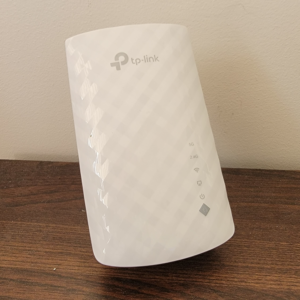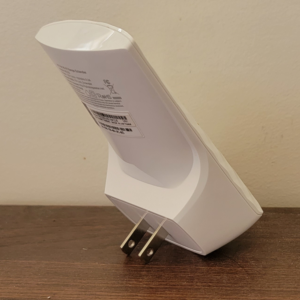Retired Techie
Getting older, not necessarily wiser!
TP-Link RE220 Review
Published on June 8, 2022 at 8:24 pm by LEWIntroduction
In this post I will be looking at the TP-Link RE2200 wifi range extender. Spoiler alert, this is a decent product that could have been exceptional.
In this review I will be covering the functionality of the product as both a wifi range extender and as a wireless adapter.
I have been using this product for a couple of years now, and have been satisfied with its performance as a wifi range extender. Where I have issue is the wireless adapter functionality. It does work, but it could have been implemented better.
Physical Product Review
The extender is a single unit that plugs directly into an outlet. Overall the construction seems average. I have dropped it a few times from modest heights and not had it break.
It stays in an outlet, unless the outlet is really worn, then like any other direct plug device gravity may come into play. The plug is oriented along the long access for vertically aligned outlets (most that I have seen in the US are aligned this way). It looks a little strange, but works correctly, in horizontally aligned outlets (something I see regularly in the Philippines).
The front of the device has a sync button and a column of LED indicators for power, LAN, Wifi, 2.4Ghz and 5Ghz. The AC plug is located on the back. On the bottom of my device is an ether jack and a reset pin hole button.
According to the specs the device will run on voltages between 100V and 240V. I have used in in the US (110V), and in the Philippines (220V).
Additionally the default IP address is 192.168.0.254, no password. The initial SSID is TP_Link_Extender.
Range Extender Setup
This is fairly straight forward. Plug the device in and wait a minute or so for it to startup. Then connect to the TP_Link_Extender with your computers wifi. You will go into a quick start wizard.
The quick start wizard will have you set your login password, and which wifi signals you are going to extend (both 2GHz and 5.4GHz). The default is to take the SSID of the selected wifi and tack ‘_EXT” onto it. However you can change it in the wizard.
Once done you will need to log back in. This can be done by using this URL http://tplinkrepeater.net. I have found this easier, as sometimes the IP address can change after setup.
Further Configuration
You can go in and configure most of the standard stuff once setup. You will probably want to specifically look at the network settings. I tend to use a static IP address, and make sure DHCP is off. You can also do other things like turn the LEDs off/on, set a power schedule, set transmitter power (called coverage), and set up access control.
Wireless Adapter Setting
One of the things you can configure is changing the device form an extender to an access point. There is a note in the manual about supporting Ethernet, my device has a Ethernet jack so I assume it is supported. Just be aware some might not have this feature.
This is where the device looses points. I feel this feature could have been better implemented. There is a mode button in the upper right corner of the web admin panel that will change the device from a repeater to a wireless adapter.
This functionality works, and it works good. However, you cannot log into the device over the LAN, you still have to log in via wireless. If I was able to login over the LAN then I would rate this device as exceptional instead of good.
I may be nit picking here, but I would like to be able to log into the device sitting at my desktop, rather than take my laptop over to the device (get in range), then do any adjustments.
Conclusion
Overall I recommend this device. It has worked good for me so far. My gripes have nothing to do with functionality, They are mainly about access mode.
I have several of these and I make good use of them, and I will probably buy them again.



Add New Comment